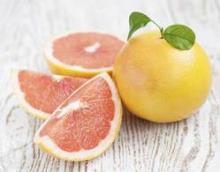Health professionals from two cohort studies who consumed citrus products more than 1.6 times a day had a 36% higher risk of developing cutaneous malignant melanoma, compared with those who consumed citrus less than twice a week, a large prospective study showed.
Among citrus products studied, consumption of whole grapefruit, but not grapefruit juice, showed the most apparent association with melanoma risk, Shaowei Wu, Ph.D., of Brigham and Women’s Hospital, Boston, and associates reported online June 29 (J. Clin. Oncol. 2015 [doi:10.1200/JCO.2014.57.4111]).
“These findings provide evidence for the potential photocarcinogenic effect of psoralen-rich foods,” the researchers wrote. “However, previous studies have also suggested that fruit intake may have potential beneficial effects for the prevention of chronic diseases, such as breast cancer and type 2 diabetes. Although our findings are consistent with evidence from animal experiments, which revealed a potential synergistic effect between psoralens and UV radiation, further investigation is needed to confirm our findings and guide sun exposure behaviors among individuals with high citrus consumption.”
For the analysis, the researchers evaluated dietary information from 63,810 women in the Nurses’ Health Study (1984-2010) and 41,622 men in the Health Professionals Follow-up Study (1986-2010). In these studies, dietary information was assessed every 2-4 years during follow-up, while incident melanoma cases were identified through self-report and confirmed by pathology.
During a follow-up period of 24-26 years, the researchers documented 1,840 incident melanomas. After adjusting for risk factors, the pooled multivariable hazard ratios for melanoma were 1.00 for overall citrus consumption less than twice per week (reference), 1.10 for two to four times per week, 1.26 for five to six times per week, 1.27 for 1-1.5 times per day, and 1.36 for 1.6 times per day or more.
“Interestingly, fresh grapefruit showed the most apparent association with melanoma among individual citrus products, which may be explained by its higher levels of psoralens and furocoumarins when compared with oranges,” wrote the researchers, who found that the pooled multivariable HR for melanoma was 1.41 for the highest consumption of grapefruit (defined as three or more times per week, versus none).
“The significant but less apparent association between [consumption of] orange juice with melanoma risk may be partly explained by its much higher consumption levels, which contributed to greater than 50% of overall citrus consumption, whereas the null association of grapefruit juice with melanoma risk may be a result of its much lower consumption levels and a large number of nonconsumers, as compared with the other individual citrus products,” they said.
In addition, Dr. Wu and associates found that the association between grapefruit consumption and melanoma was more apparent among those with a history of sunburn and higher exposure to UV radiation. The association also appeared to be stronger “for melanomas on body sites with higher continuous sun exposure (e.g., head, neck, and extremities) than for melanomas on body sites with lower continuous sun exposure (e.g., truncal sites), which may suggest a potential synergistic effect between dietary consumption and solar UV radiation.”
They acknowledged certain limitations of the study, including the fact that the dietary data were self-reported and that the two cohorts were “mostly comprised [of] white, educated U.S. health professionals, which potentially limits the generalizability of the findings.”
Dr. Wu and five coauthors reported having no financial disclosures. A seventh coauthor, Dr. Abrar A. Qureshi, disclosed that he has a consulting or advisory role with Abbvie, Novartis, Janssen Pharmaceuticals, and Pfizer. He also has received research funding from Regeneron.


